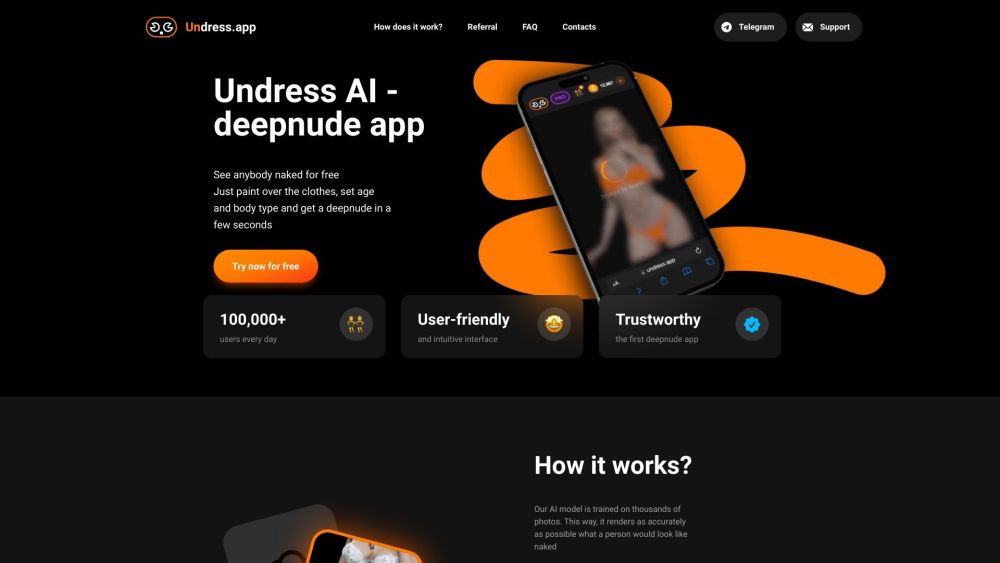Free Undress AI: The Hype, The How-To, And Is It Safe? Find Out!
Ever wondered if technology could peel back the layers of reality, pixel by pixel? The rise of "undress AI" is not just a technological advancement, it's a cultural earthquake, reshaping boundaries of privacy, art, and personal expression.
The digital realm is rapidly evolving, and with it, the capabilities of artificial intelligence. One of the most intriguing, and perhaps controversial, developments is the emergence of "undress AI" – a technology that uses sophisticated algorithms to digitally remove clothing from images. This raises profound questions about ethics, privacy, and the very nature of digital art. While the concept might seem like a futuristic fantasy, it is now a tangible reality, sparking both excitement and apprehension across various sectors.
The core technology behind undress AI relies on deep learning, a subset of artificial intelligence that enables computers to learn from vast amounts of data. Specifically, these AI systems are trained using extensive datasets of images, both clothed and unclothed, allowing them to recognize and simulate the human body beneath garments. By employing models like Stable Diffusion and Generative Adversarial Networks (GANs), the AI can generate realistic versions of images where clothing is digitally removed. This process involves intricate calculations and estimations, filling in the missing information with what the AI "believes" to be the most plausible outcome.
Several platforms and tools have emerged, each offering unique features and capabilities in the realm of AI-driven image manipulation. Undress AI services like Undress AI and UndressApp, for example, provide users with the ability to upload a photo and receive a modified version within minutes. These services often boast user-friendly interfaces and claim to offer seamless, innovative experiences. Similarly, tools like Clothoff and Slazzer 3.0 aim to provide precise and realistic results, allowing users to explore the creative potential of AI image editing. While some tools focus on simplicity and ease of use, others offer more advanced settings and customization options.
The applications of undress AI extend beyond mere novelty. For fashion designers and creative professionals, these tools can be used to transform portraits and experiment with different outfit styles and designs. By digitally undressing a model, designers can visualize how clothing might look on the human body without the need for physical fittings or photoshoots. This can be particularly useful in the early stages of design, allowing for rapid prototyping and experimentation. Furthermore, AI-driven image editing can serve as a form of artistic expression, enabling users to push the boundaries of traditional editing tools and explore their creativity in new and innovative ways.
However, the proliferation of undress AI also raises significant ethical and privacy concerns. The ability to digitally remove clothing from images can be misused for malicious purposes, such as creating non-consensual pornography or engaging in revenge porn. This poses a serious threat to individual privacy and can have devastating consequences for victims. Furthermore, the accuracy and realism of these tools can blur the lines between reality and fabrication, making it difficult to distinguish between genuine and manipulated images. This can erode trust in digital media and create a climate of uncertainty and suspicion.
Many platforms that offer undress AI services claim to prioritize user privacy and security. Some services assert that uploaded images are not stored on servers and that user actions are not published anywhere. However, these claims should be viewed with skepticism, as the potential for misuse and data breaches always exists. It is crucial for users to exercise caution and carefully consider the risks before using undress AI tools. Furthermore, developers and providers of these technologies have a responsibility to implement safeguards and ethical guidelines to prevent misuse and protect user privacy.
The legal landscape surrounding undress AI is still evolving, and many jurisdictions have yet to address the specific issues raised by this technology. In some countries, the creation and distribution of non-consensual deepfakes, including digitally altered images, may be subject to criminal penalties or civil lawsuits. However, the lack of clear legal frameworks can make it difficult to prosecute offenders and protect victims. It is essential for lawmakers to address the legal gaps and create comprehensive legislation that protects individual privacy and holds perpetrators accountable for their actions.
The rise of undress AI is prompting a broader societal conversation about the ethics of artificial intelligence and its impact on privacy, consent, and digital identity. As AI technologies become more sophisticated and pervasive, it is crucial to develop ethical frameworks and guidelines that ensure these tools are used responsibly and ethically. This requires a multi-stakeholder approach, involving technologists, policymakers, ethicists, and the public, to address the complex challenges posed by AI and shape its development in a way that benefits society as a whole.
Several tools in the market offer to perform AI undressing, but their effectiveness and ethical implications vary greatly. Undress AI, accessible through platforms like UndressAI.io, claims to offer quick results, transforming uploaded photos into nude versions within minutes. Muke AI Undress is another contender, allowing users to upload photos and purportedly "remove clothes" to create deepnudes. Undressher is advertised as a free app that flawlessly undresses people in photos. Clothoff offers a similar service, promising to remove clothes from photos online instantly. Infatuated.ai touts its ability to produce realistic results with just a few clicks, using AI-powered editing to simulate outfit removal.
While many of these tools promise ease of use, the actual process can vary. Generally, users upload a photo to the platform, and the AI processes the image, attempting to remove clothing and reconstruct the underlying body. Some tools offer adjustable settings, allowing users to fine-tune the results, while others operate with a single-click approach. The quality of the output depends on the sophistication of the AI algorithms and the training data used to develop them. Some services, like Undress AI, utilize deep learning algorithms, including stable diffusion and generative adversarial networks (GANs), to generate realistic results.
Ethical considerations are paramount when discussing undress AI. The creation of deepnudes without consent is a serious violation of privacy and can have severe psychological and emotional consequences for the individuals involved. Many platforms claim to prioritize user privacy, asserting that images are not stored on servers and that actions are not published. However, these assurances are often insufficient to mitigate the risks. The technology itself is trained on large datasets, which may introduce biases and inaccuracies. Furthermore, the potential for misuse, such as creating fake evidence or engaging in harassment, is substantial.
Legally, the use of undress AI to create non-consensual pornography can lead to criminal charges in many jurisdictions. However, the legal landscape is still evolving, and it can be challenging to prosecute offenders, especially if the images are created and distributed anonymously. The lack of clear legal frameworks highlights the need for updated laws that address the unique challenges posed by AI-generated content. Moreover, international cooperation is essential to combat the global spread of non-consensual deepfakes.
The technology behind these tools often relies on generative adversarial networks (GANs). GANs consist of two neural networks: a generator and a discriminator. The generator creates synthetic images, while the discriminator evaluates whether the images are real or fake. Through iterative training, the generator becomes increasingly adept at producing realistic images, and the discriminator becomes better at detecting fakes. This process allows the AI to learn complex patterns and generate high-quality outputs. However, the reliance on large datasets can also introduce biases. For example, if the training data primarily consists of images of female subjects, the AI may perform better on female images than on male images.
Several companies offer tools that remove or replace clothing in images using AI. Slazzer 3.0 is a free online tool that claims to remove clothes from images with high accuracy. AI Image Magic Cleanup is another free option. These tools often provide users with a range of outfit style options, allowing them to transform and modify character outfits with ease. The technology behind these tools is rapidly advancing, and the quality of the results is improving over time.
Beyond the ethical and legal implications, the use of undress AI raises broader questions about societal norms and expectations. The proliferation of these tools can contribute to the objectification of individuals and normalize the creation and distribution of non-consensual content. It is essential to promote responsible use of technology and to foster a culture of respect and consent. Education and awareness campaigns can help individuals understand the risks and consequences associated with undress AI and encourage them to make informed decisions about their online behavior.
Protecting privacy and security should be a top priority when using or developing AI-based image manipulation tools. Platforms should implement robust security measures to prevent unauthorized access to user data and to protect against data breaches. Users should also take steps to protect their own privacy, such as using strong passwords, enabling two-factor authentication, and carefully reviewing the terms of service of any platform they use. It is also important to be aware of the potential for social engineering attacks and to be cautious when sharing personal information online.
The future of undress AI is uncertain, but it is likely that the technology will continue to evolve and become more sophisticated. As AI algorithms improve and training datasets expand, the quality of the generated images will likely increase. This could lead to new applications in fields such as fashion design, entertainment, and law enforcement. However, it also raises the stakes in terms of ethical and legal considerations. It is essential for policymakers, technologists, and the public to engage in ongoing dialogue to address the challenges and opportunities presented by undress AI.
The rise of free AI clothes remover websites has made it easier than ever to remove clothing from photos online. These tools often offer a range of features, such as adjustable settings, one-click transformations, and realistic results. However, users should be aware of the ethical and legal implications of using these tools and should take steps to protect their privacy and security. The development and use of undress AI should be guided by ethical principles and respect for individual rights.
Ultimately, the undress AI technology offers precise and realistic results. The Undressher app flawlessly undresses people in photos, providing an unparalleled user experience that’s leagues ahead of the rest. Don't worry about any prompt words you enter, or AI prompt records being leaked, we 100% guarantee your personal privacy. Feel free to release all your deepest desires and try AI clothes removal for free. Easily unlock your artistic fantasy with our AI undress generator and use the AI art generator to create any unrestricted AI undress image, no matter realistic or anime style. Get started for free.



Detail Author:
- Name : Dr. Annabelle Durgan II
- Username : rodriguez.king
- Email : carolyne.barton@rath.info
- Birthdate : 1992-11-13
- Address : 27907 Bode Lodge Suite 887 East Brannon, ND 29327
- Phone : (325) 446-7366
- Company : Cruickshank-Brakus
- Job : Radio and Television Announcer
- Bio : Sunt laborum ipsam ut voluptatibus libero. Ut aut est quod rerum dolorem consequatur exercitationem. Distinctio eius eius nobis.
Socials
facebook:
- url : https://facebook.com/eladio.fritsch
- username : eladio.fritsch
- bio : Dolorem consequuntur delectus deserunt ut aut error recusandae.
- followers : 4483
- following : 910
instagram:
- url : https://instagram.com/fritsch1972
- username : fritsch1972
- bio : Maxime iste sit non asperiores. Voluptate quasi in sunt suscipit possimus.
- followers : 5755
- following : 416
tiktok:
- url : https://tiktok.com/@eladio7694
- username : eladio7694
- bio : Exercitationem debitis cumque alias excepturi.
- followers : 731
- following : 1158
twitter:
- url : https://twitter.com/fritsche
- username : fritsche
- bio : Illum ut consequatur architecto magnam alias. Natus maxime officia ad id autem nihil. Aspernatur voluptatum earum vitae rerum fugit.
- followers : 4855
- following : 577
linkedin:
- url : https://linkedin.com/in/efritsch
- username : efritsch
- bio : Maxime sed aperiam sed sed aut ut commodi.
- followers : 873
- following : 2016